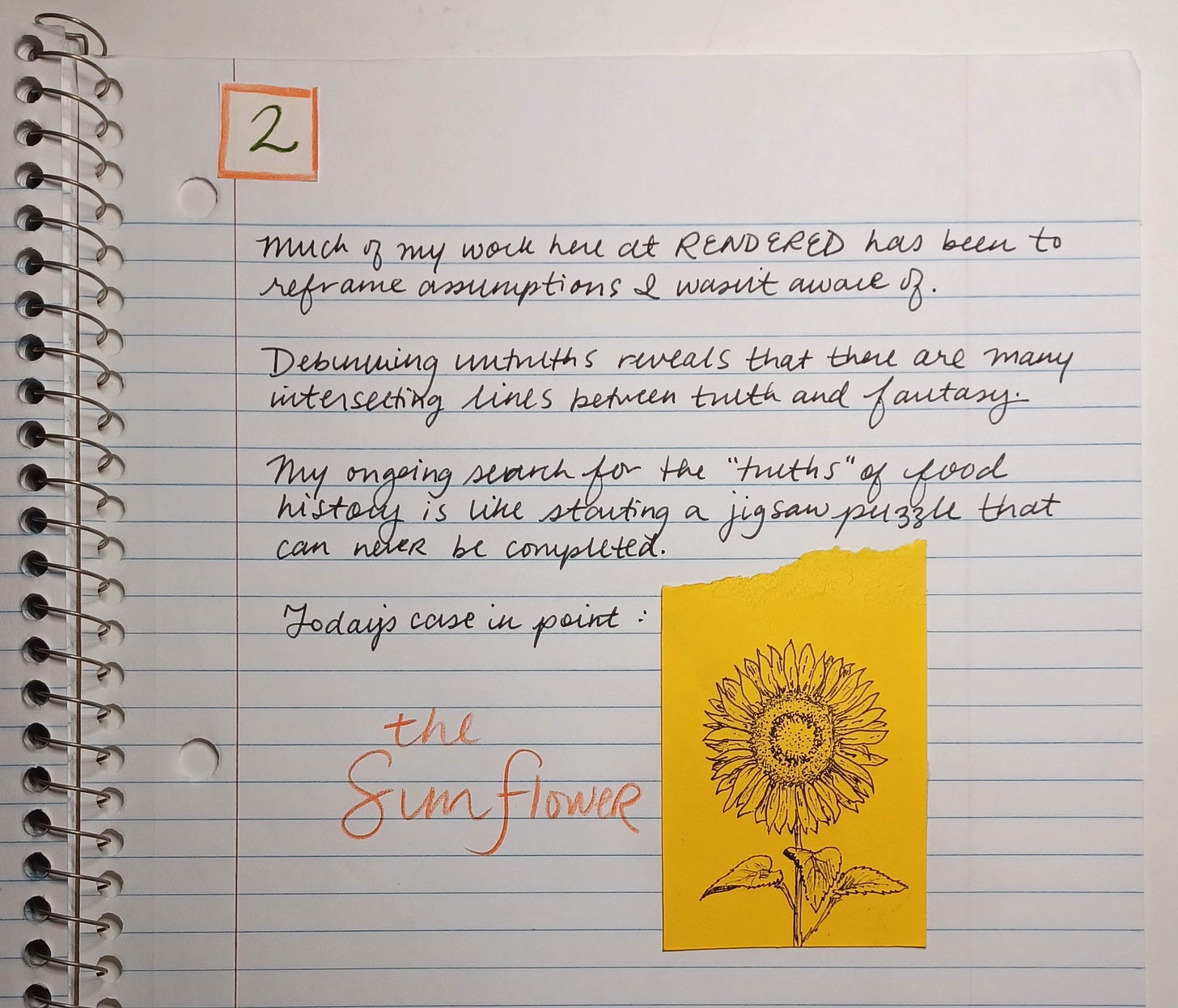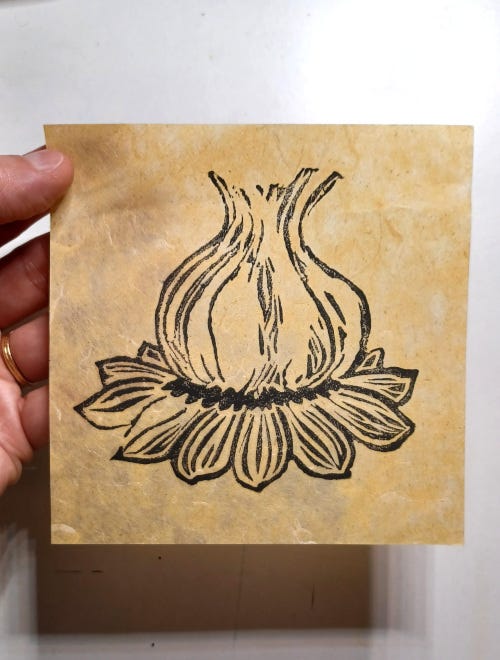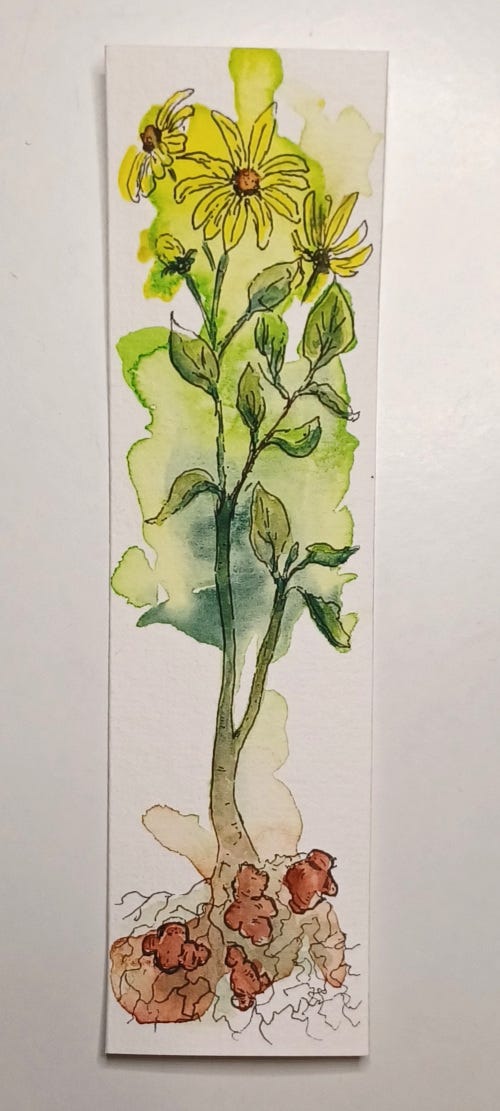Hello, and welcome back to RENDERED! I’m in an experimental phase with this newsletter–the personal anecdote is handwritten, and the essay begins below. Happy Reading!
Also, if you filled out my reader survey, please let me know so that I can gift you one month of access to paid content!
Sunflowers belong to the genus Helianthus, which is composed of more than 50 wild species. These sunflower varieties originated in North America, mostly between southern Canada and the Trans-Mexican volcanic belt (in central-southern Mexico).
Pre-Columbian indigenous uses for sunflowers ranged from practical to spiritual, and go back thousands of years. Coprolites (aka. fossilized human poop) from Ocampo Cave in Tamaulipas, central Mexico, show that sunflower seeds were eaten by humans more than 4000 years ago. Aside from eating the seeds, other North American indigenous uses for sunflowers include sunscreen, dyeing (the Hopi sunflower produces a purple dye), medicinal, ornamental, and ritual.
In today’s eastern United States, sunflowers provided an important source of oil. Further south, in now-Mexico, sunflowers were still grown for their nutritious seeds, but because there were other sources of natural oils like cacao and avocado, they also took on a different range of uses.
By studying ancient sunflower seeds, scientists can tell a wild variety from a domesticated one–this is one method by which we’ve learned that indigenous peoples have been domesticating sunflowers for thousands of years. Evidence of this goes back to at least 2600BC at the San Andrés site in Tabasco, southern Mexico, where domesticated seeds were found in burial sites, likely left as ritual offerings.
In the Aztec mythos, sunflowers held great symbolic meaning. They were associated with the god of war, the solar deity and patron god of the Aztecs, Huitzilopochtli. Sunflower achene offerings were found in Tenochtitlan, and evidence of their medicinal, ornamental, religious, and ceremonial use was observed by Spanish conquistadors.
During their conquest, one of the tools of the colonizer’s handbook was cultural suppression–the sunflower was one of its many targets.
We need only look to the Paradise Garden Murals of Malinalco to see an example of this spiritual annihilation. Today known as a “Pueblo Mágico” (or “Magic Town”) 90km southwest of Mexico City, it is a destination with a complicated history. The site was formerly an Aztec sanctuary that was converted into an Augustinian monastery in the 16th century. There, the Murals of the Divine Savior were painted to portray an image of Paradise: Spanish Catholic iconography was combined with indigenous flora and fauna to create a hybridized vision of Utopia. But among all the native species featured in the murals, there is one notable plant missing–the sunflower. This omission is glaring, and certainly not accidental.
While the Spanish were suppressing the importance of the sunflower in the so-called New World, Columbus and his cronies were shipping its seeds back to Spain. One of many mysterious, heretofore unknown plants, it held great value as a botanical curiosity.
This era of colonization helped inspire a “botanical renaissance,” an upsurge of interest in plant studies in Europe. Printing presses and woodblock illustration were proliferating across the continent, which meant that books and images were spreading information faster than ever. With all these new plant species coming from the colonies, there was much research to be done. Physicians were largely the ones studying these plants, branching out from herbalism into the burgeoning new field of botany.
Botanical gardens were created during this time, as sites of scientific research. The Botanical Garden of Padua, founded in 1545, is a UNESCO World Heritage site and the oldest such institution still in operation. This was one notable place where early sunflower research was conducted.
European botanists were “discovering” a plant which had already enjoyed a thousands-year-old history in the Americas. At first, sunflowers in Europe were almost exclusively considered ornamental, and information about its other uses (except medicinal) was unknown. Before 1600, based on the limited number of specimens there were to inspect, only four varieties of sunflower were identified. Dodonaeus, the Flemish “Father of Botany” first assigned the name Chrysanthemum Peruvianum to the sunflower, writing that they originated in Peru. In early European writings about the New World, “from Peru” was code for “from somewhere in the Americas.”
Scientific “objective” reality for those early botanists meant classifying the unfamiliar, based on a severely limited dataset. Extrapolating “universal truth” from incomplete shreds of information is easy to judge as myopic from today’s standards.
Historical misunderstandings are being corrected with the help of contemporary scholars; like archaeologists, historians, botanists, and linguists in the case of the sunflower.
But we understand today that pure scientific objectivity is a myth. Any set of information will invariably be tainted by human subjectivity.
We can never know the true history of the sunflower–cultural genocide, fragmented secondhand information and guesswork act hand-in-hand with the entropy of time.
Debunking untruths reveals the many intersecting lines between the truth and the unknowable.
BONUS ILLUSTRATION: “Helianthus tuberosus” (Aka. Jerusalem artichoke, sunchoke, topinambur)
Jerusalem artichokes, or topinamburs, are the edible roots of a sunflower, Helianthus tuberosus. My husband’s late grandmother hated them, having had to eat so many of them in the years during and after World War II. During the Nazi occupation of France, foods like meat and potatoes were largely inaccessible to civilians, and rationing was in full effect. The French depended on other root vegetables like rutabagas and topinamburs, which had been mostly used for animal feed before the war. For those who lived through WWII and the postwar food rations, those root veggies bring back bad memories, and were thus shunned from many family kitchens for decades afterwards.
Thank you for reading, and for your patience. This year I’ve had to reorganize my creative practice in the interest of longevity, and my own well-being. RENDERED is a one-woman production, and your support is appreciated. This newsletter’s format will be changing in 2025, and I will announce those changes on January 1. Until then, you can follow me on Instagram. Be well, and I’ll be back soon.
Bibliography
“Botanical Garden (Orto Botanico), Padua.” UNESCO World Heritage Convention. https://whc.unesco.org/en/list/824/
Coen Hird, Dominique M. David-Chavez, Shanny Spang Gion, Vincent van Uitregt. “Moving beyond ontological (worldview) supremacy: Indigenous insights and a recovery guide for settler-colonial scientists.” J Exp Biol 15 June 2023; 226 (12): jeb245302. doi: https://doi.org/10.1242/jeb.245302
Feinberg, Melanie. “The Myth of Objective Data.” MIT Press Reader, 17 Apr 2023. https://thereader.mitpress.mit.edu/the-myth-of-objective-data/
Giannini, Vittoria, Carmelo Maucieri, Teofilo Vamerali, Giuseppe Zanin, Stefano Schiavon, Davide Matteo Pettenella, Stefano Bona, and Maurizio Borin. 2022. "Sunflower: From Cortuso’s Description (1585) to Current Agronomy, Uses and Perspectives" Agriculture 12, no. 12: 1978. https://doi.org/10.3390/agriculture12121978
Heiser, Charles B. “The Sunflower among the North American Indians.” Proceedings of the American Philosophical Society, vol. 95, no. 4, 1951, pp. 432–48. JSTOR, http://www.jstor.org/stable/3143283. Accessed 26 Sept. 2024.
Lentz, David L., et al. “Sunflower (Helianthus Annuus L.) as a Pre-Columbian Domesticate in Mexico.” Proceedings of the National Academy of Sciences of the United States of America, vol. 105, no. 17, 2008, pp. 6232–37. JSTOR, http://www.jstor.org/stable/25461773. Accessed 26 Sept. 2024.
Machemer, Theresa. “France Is Slowly Bringing Back Its ‘Forgotten Vegetables.’” Smithsonian Magazine, 30 Apr 2020. https://www.smithsonianmag.com/smart-news/france-slowly-bringing-back-its-forgotten-vegetables-180974780/









I have always loved sunflowers because of their varying appearances. Now I see that they have an extensive pedigree which adds to their beauty. I especially like the image Sunflower Fam. Would love to see it replicated among your handicrafts 🥰